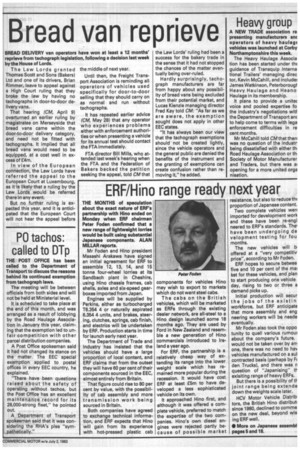ERF/Hino range ready next year
Page 5

If you've noticed an error in this article please click here to report it so we can fix it.
THE MONTHS of speculation about the exact nature of ERF's partnership with Hino ended on Monday when ERF chairman Peter Foden confirmed that a new range of lightweight lorries would be built using substantial Japanese components. ALAN MILLAR reports.
Mr Foden and Hino president Masashi Arakawa have signed an initial agreement for ERF to assemble 12, 13, 14, and 15 tonne four-wheel lorries at its Sandbach plant in Cheshire, using Hino chassis frames, cab shells, axles and six-speed gearboxes imported from Japan.
Engines will be supplied by Perkins, either as turbocharged T6.354 4 or naturally aspirated 6.354 4 units, and brakes, steering, clutches, springs, cab finish, and electrics will be undertaken by ERF. Production starts in time for launch early next year.
The Department of Trade and Industry has insisted that the vehicles should have a large proportion of local content, and ERF claims that from the outset they will have 60 per cent of their components sourced in the EEC, almost entirely from Britain.
That figure could rise to 80 per cent by value, with the possibility of cab assembly and more transmission work being sourced in Britain.
Both companies have agreed to exchange technical information, and ERF expects that Hino will gain from its experience with hot-pressed plastic cab components for vehicles Hino may wish to export to markets which do not want steel cabs.
The cabs on the British vehicles, which will be marketed as ERFs through the existing dealer network, are all-steel to a Hino design launched some 18 months ago. They are used by Ford in New Zealand and resemble a new generation of Hino commercials introduced to Ireland a year ago.
For ERF, the partnership is a relatively cheap way of extending its range into the lower weight scale which has remained more popular during the recession. It would have cost ERF at least £5m to have developed a less sophisticated vehicle on its own.
It approached Hino first, and although it was offered a complete vehicle, preferred to match the expertise of the two companies. Hino's own diesel engines were rejected partly beca u se of possible market resistance, but also to reduce th( proportion of Japanese content. Two complete vehicles wen imported for development work
and these have been re-engi neered to ERF's standards. The, have been undergoing de velopment testing for fou months.
The new vehicles will b, offered at a "very competitiv price", according to Mr Foden.
ERF hopes to secure betwee five and 10 per cent of the mai ket for these vehicles, and plan to start producing one vehicle day, rising to two or three a demand picks up.
Initial production will secur the jobs of the existin workforce, but ERF anticipate that more assembly and eng neering workers will be neede eventually.
Mr Foden also took the oppo tunity to quell various rumour about the company's future. would not be taken over by am one, there was no need to hav vehicles manufactured on a sul contracted basis (perhaps by R den Trucks), and there was n question of "Japanising" if exisiting range of heavy ERFs.
But there is a possibility of if joint range being extende down the weights scale later.
HCV Motor Vehicle Distribi tors, the British Hino distributi since 1980, declined to comme on the new deal, beyond wis ing ERF well.
• More on Japanese assembl pages 5 and 18.




































































































